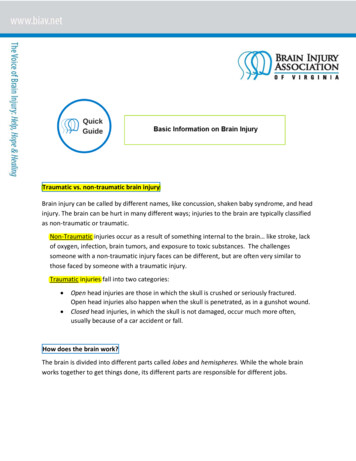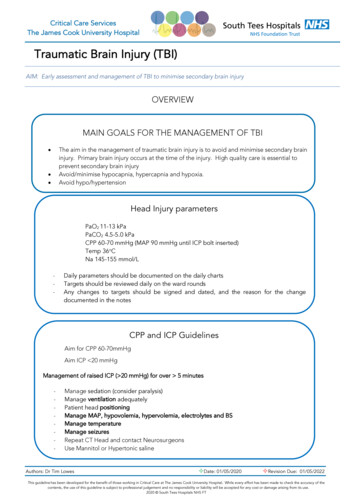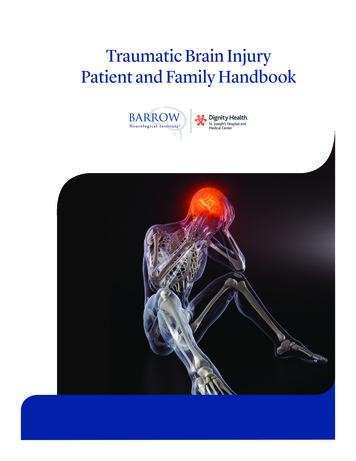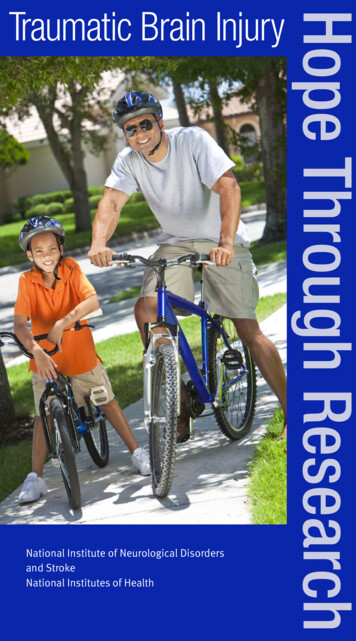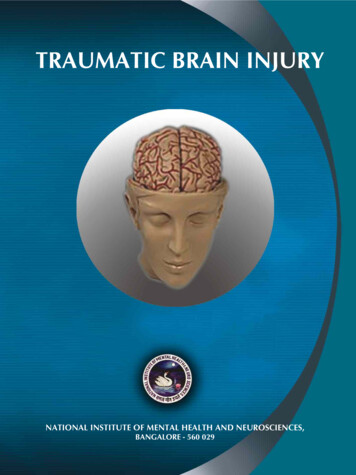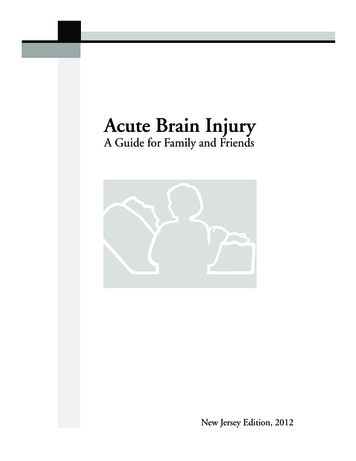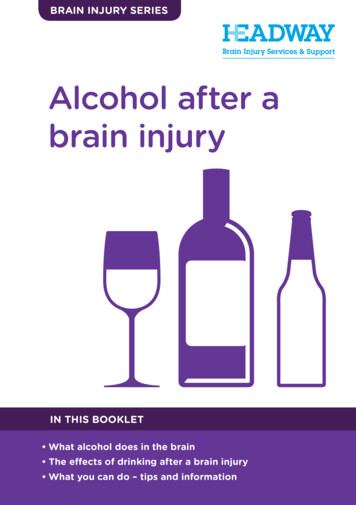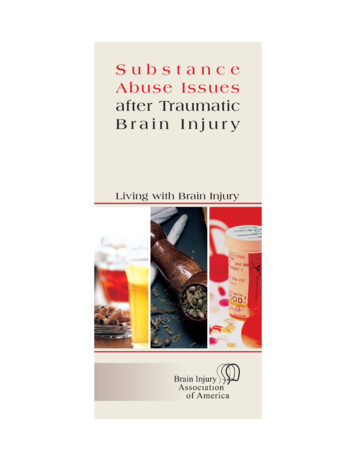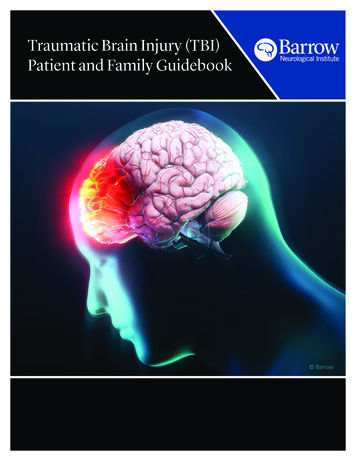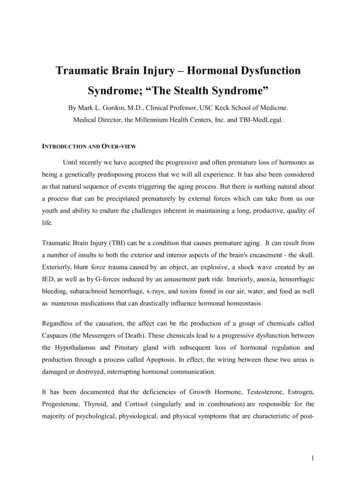
Transcription
Traumatic Brain Injury – Hormonal DysfunctionSyndrome; “The Stealth Syndrome”By Mark L. Gordon, M.D., Clinical Professor, USC Keck School of Medicine.Medical Director, the Millennium Health Centers, Inc. and TBI-MedLegal.INTRODUCTION AND OVER-VIEWUntil recently we have accepted the progressive and often premature loss of hormones asbeing a genetically predisposing process that we will all experience. It has also been consideredas that natural sequence of events triggering the aging process. But there is nothing natural abouta process that can be precipitated prematurely by external forces which can take from us ouryouth and ability to endure the challenges inherent in maintaining a long, productive, quality oflife.Traumatic Brain Injury (TBI) can be a condition that causes premature aging. It can result froma number of insults to both the exterior and interior aspects of the brain's encasement - the skull.Exteriorly, blunt force trauma caused by an object, an explosive, a shock wave created by anIED, as well as by G-forces induced by an amusement park ride. Interiorly, anoxia, hemorrhagicbleeding, subarachnoid hemorrhage, x-rays, and toxins found in our air, water, and food as wellas numerous medications that can drastically influence hormonal homeostasis.Regardless of the causation, the affect can be the production of a group of chemicals calledCaspaces (the Messengers of Death). These chemicals lead to a progressive dysfunction betweenthe Hypothalamus and Pituitary gland with subsequent loss of hormonal regulation andproduction through a process called Apoptosis. In effect, the wiring between these two areas isdamaged or destroyed, interrupting hormonal communication.It has been documented that the deficiencies of Growth Hormone, Testosterone, Estrogen,Progesterone, Thyroid, and Cortisol (singularly and in combination) are responsible for themajority of psychological, physiological, and physical symptoms that are characteristic of post-1
concussion syndrome (PCS), post-traumatic stress syndrome(PTSS), and post traumatic braininjury(PTBI).Symptoms frequently precede the detection of the underlying hormone deficiencies, that is, ifthey are even looked at. In one clinical study, 56% of the group had one or more hormonaldeficiencies within 3 months of the neurotrauma. In a meta-analysis of hormonal deficienciesarising out of TBI, the outcome was between 48% and 80%.Radiologic assessment of the intracranial impact of TBI has become a science unto itself with thenewer technologies helping to better define damaged areas of the brain. A number ofcontemporary radiologic studies have statistically documented common areas of the brain thatfall first victim to TBI. It was not surprising to see that the Hippocampus was a commonlydamaged area knowing that many patients with TBI suffer from memory related deficits.Early laboratory assessment of the patient with TBI can monitor and document the sometimesudden if not progressive decrease in hormones. Then the logical challenge becomes treatmentbased upon replacement or supplementation of the insufficient or deficient hormone(s).Traditionally, treatment has been with psychotropic drugs (anti-depressants, anti-anxiety, antipsychotic, anti-epileptic, and anti-life) and psychotherapy with poor quality of life outcome.This has been nothing more than treating the superficial symptoms and not the underlying causeand that is the “Stealth Syndrome”.This paper will consider the incidence, clinical course, diagnosis, and treatment of post TBIhormonal dysfunction syndrome – pTBI-HDS.A CHANGE IN CONCEPTS BASED UPON sicians(InterventionalEndocrinologists) accepted the on-set and progression of hormone deficiencies as being a part ofthe natural aging process. This was loosely taken to be around the 4th decade of life when malesstart to loose testosterone and females begin the downward spiral leading to menopause basedupon estrogen, progesterone, and testosterone deficiencies. During this progression there are2
variable but significant adverse changes in one’s psychological, physiological, and physical wellbeing that seems to correlate greater with pituitary hormone deficiencies than with one’s age.Although the relationship between neurotrauma and hormonal deficiencies has been inthe medical literature for decades, its place in clinical medicine has been obscured until recently.Nonetheless, there is still academic resistance challenging the criteria that we use to definesomeone with a hormonal deficiency as well as the optimal treatment.INCIDENCEPost Traumatic Brain Injury-Hormone Dysfunctional Syndrome is typically associatedwith severe head traumas with a Glasgow Coma Score (lowest 3 and highest 15) of less than 7 or8 with loss of consciousness and coma. Survivors of such head trauma often suffer fromimpairment of cognition, language, and mood, as well as physical functioning. However, morerecent research by Kelly et al suggest that relatively mild head trauma can be enough to cause aTBI with development of hormone regulatory dysfunction.Motor vehicle accidents and sports, such as boxing, martial arts, wresting, football, arecommon causes of TBI. As are slip and falls, blunt trauma, and shaken trauma. Even seeminglyinnocuous rides at amusement parks can be violent enough to cause jarring of the stock of thepituitary that can predispose us to TBI.An estimated 1.9 million Americans sustain a TBI each year with approximately 52,000of those people dying from their injuries on the spot. Anywhere from 300,000 to 380,000 end upin an emergency room or are hospitalized for observation. The remaining individuals “shake itoff” and go home unaware of the smoldering process that continues as they sleep.Of those thatsurvive, many will go on to develop progressive hormonal deficiencies (accelerated bysubsequent TBI), which leads to pTBI-HDS. This “Stealth Syndrome” is frequently subtle,frequently unaddressed, and frequently under-diagnosed.The leading causes of TBI are: Falls (28%);Motor vehicle-traffic crashes (20%);3
Struck by/against events (19%); andAssaults (11%).VETERANS AND TRAUMATIC BRAIN INJURYNeurologists affiliated with the U. S. military now estimate that up to 30% of troops who havebeen on active duty for 4 months or longer (in both Iraq and Afghanistan) are at risk of someform of disabling neurological damage. This is partly based on the knowledge that closed headinjuries far outnumber the penetrative head injuries on which official statistics are based. So,while official figures put the number of U. S. troop casualties in Iraq and Afghanistan at 22,600(as of November 2006), there may be up to 150,000 already suffering from TBI.These same neurologists are among those who have highlighted the Bush administration’sneglect of its injured troops. They emphasize the need for prompt diagnosis and evaluation oftroops who have sustained TBI, as well as improved methods for screening returning troops forbrain damage and better monitoring of injured troops’ progress during treatment andrehabilitation. The Veterans Affairs and Armed Services Committee set aside 3.75 million forthe creation of a computer-based system for the measurement of cognitive functions in troopsbefore and after deployment to war zones. The Pre-deployment Testing was started this past yearat Fort Collins, Kentucky. Congress recently authorized 450 million from the Iraq spending billfor research into TBI.SYMPTOMATOLOGYWhether the trauma is mild, moderate, or severe it still can cause the brain’s ability to regulateimportant life maintaining hormones to fail. The loss of these hormones increases the risk ofheart attack, stroke, emotional instability, depression, anxiety, mood swings, memory loss,fatigue, confusion, amnesia, poor cognition, learning disabilities, decreased communicationskills, poor healing, frequent infections, poor fracture healing, poor skin quality, increased bodyfat, decreased muscle strength and size, infertility, and loss of sex drive.NEURORADIOLOGY AND TBIRadiologic evidence for identification of specific neuroimaging findings indicative ofTBI has been advanced with use of the 1.5- and 3.0-Tesla high-field MRI. In a 2009 study4
presented by Dr. Orrison, et al, They assessed 100 unselected consecutive examinations ofprofessional unarmed combatants to determine the extent of identifiable TBI findings. Thepercentage of positive findings and the localization of lesions were quantified using the checklistthat included the MRI findings previously reported in the medical literature. Seventy-six percentof the unarmed combatants had at least one finding that may be associated with TBI: 59%hippocampal atrophy, 43% cavum septum pellucidum, 32% dilated perivascular spaces, 29%diffuse axonal injury, 24% cerebral atrophy, 19% increased lateral ventricular size, 14% pituitarygland atrophy, 5% arachnoid cysts, and 2% had contusions. The improved resolution andincreased signal-to-noise ratio on 1.5- and 3.0-Tesla high-field MRI systems defines the range ofpathological variations that may occur in professional unarmed combatants. Additionally, the useof a systematic checklist approach insures evaluation for all possible TBI-related abnormalities.This knowledge can be used to anticipate the regions of potential brain pathology for radiologistsand emergency medicine physicians, and provides important information for evaluating unarmedcombatants relative to their safety and long-term neurocognitive outcome.CLINICAL COURSEThere are three phases to post TBI hormonal deficiency syndrome: acute, recovery, andthe chronic phase.Aimaretti et al found GH deficiency and secondary hypogonadism were the mostcommon acquired pituitary defects induced by TBI in the transition phase (pediatric toadolescent). The results of this study suggest that it is extremely important to give allprepubescent children who have sustained a head injury a total hormone assessment, because thathead injury may cause pTBI-HDS, which could cause a whole range of problems, including shortstature, personality changes, functional disability, and problems with language skills and schoolskills. The most recent literature suggests that hormone levels should be determined immediatelyafter the injury and then again a few weeks later.Schneider et al studied the prevalence of anterior pituitary insufficiency at 3 and 12months after TBI. Results showed that 56% of TBI patients had anterior pituitary insufficiency at3 months and 36% at 12 months. Leal-Cerro et al conducted a similar study investigating theprevalence of TBI-mediated hypopituitarism in patients who had sustained a sever TBI within5
the last five years. Results showed that 17% had gonadotrophin deficiency, 6.4% hadadrenocortiocotrophic (ACTH) deficiency, 5.8% were with thyroid stimulating hormone (TSH)deficiency, and 1.7% developed diabetes insipidus. Overall, 24.7% of participants developedsome type of pituitary hormone deficiency.Kelly et al found that chronic GH deficiency developed in 18% of patients withcomplicated mild, moderate, or severe TBI, and was associated with depression and diminishedquality of life. Whilst Powner et al found chronic hormonal deficiencies occurs in 30-40% ofpatients after TBI, with 10-15% of patients having more than one deficiency. Like Kelly, Pownerdocumented 15-20% of TBI patients go on to develop GH deficiency. Results of the study byPowner et al showed that 15% of TBI patients develop gonadal hormone deficiencies and 1030% developed hypothyroidism. The researchers found that chronic adrenal failure is widespreadamongst TBI patients and that nearly a third have elevated prolactin levels.Koponen et al conducted a 30-year follow-up study on patients who had suffered TBI todetermine the occurrence of psychiatric disorders. Their results showed that 48.3% of studyparticipants had had an axis I disorder that began after TBI. The most common disorders afterTBI were: major depression (26.7%), alcohol abuse or dependence (11.7%), panic disorder(8.3%), specific phobia (8.3%), and psychotic disorders. Nearly a quarter (23.3%) developed atleast one personality disorder. These findings led the researchers to conclude: “The resultssuggest that traumatic brain injury may cause decades-lasting vulnerability to psychiatric illnessin some individuals. Traumatic brain injury seems to make patients particularly susceptible todepressive episodes, delusional disorder, and personality disturbances. The high rate ofpsychiatric disorders found in this study emphasizes the importance of psychiatric follow-upafter traumatic brain injury.”THE MILLENNIUM’S APPROACH TO NEUROTRAUMA RELATED HORMONAL DYSFUNCTIONIn order to optimally treat pTBI-HDS those hormones that are insufficient or deficientneed to be identified. Important points to remember when you suspect that a patient may havesustained a potential neurotrauma;6
It is vital not to use the intensity of the trauma to predict the onset of post TBI hormonaldysfunction syndrome – even the most subtle of injures can precipitate TBI. It is vital that you perform comprehensive hormonal testing immediately after theprecipitating event to establish a baseline (IGF-1, TSH, LH, FSH, PR, Cortisol, etc). Do not use age as a predictor. Even in a 45-year-old patient it is vital to inquire about anyhistorical head trauma – even head trauma that occurred in their childhood. Although GH cannot be used at present for the treatment of TBI, it can still be used totreat Adult GH Deficiency Syndrome (AGHDS). However, being aware of the etiologyof such a deficiency is extremely important because you may need to adopt a totallydifferent approach to a patient’s treatment. Consider early hormonal supplementation to minimize the psychological, physiological,and physical sequelae. Hormonal assessments can be done at three-month intervals from the date of injury, ormore frequently based upon treatment. A comprehensive cognitive, laboratory, radiological, and confrontational examination ofthe TBI patient is being developed by the Millennium and will be available atwww.tbimedlegal.comCONCLUSIONThere are already 4.7 million people walking around with the residual affects ofTraumatic Brain Injury. On top of this number there are an additional 300,000 – 380,000 moreindividuals who have sustained a significant TBI. At the present time, treatment has been basedupon therapies that only mask the underlying condition of hormonal deficiencies and do nothingto correct them.Addressing the 300,000 plus returning veterans with TBI, the government has set up acenter at Fort Collins Kentucky under Dr. Twillie, who puts the soldiers through a battery of teststo measure different cognitive functions. Visual tests show how fast and accurately a soldier canrecognize letters, a driving simulator gives soldiers the feeling of driving under differentenvironmental conditions and a Nintendo Wii game system, with its motion-sensitive controller,helps with coordination skills. Once a soldier's individual deficiencies are identified, therapy canbe designed to help retrain the brain to overcome those problems, Twillie said.7
In a review of the available government protocols, there was no document found thatdiscussed the association of TBI with hormonal deficiencies in light of the overwhelmingmedical literature that addresses the underlying and stealth condition of TBI-HDS.For that reason, the Millennium Health Centers, Inc. though it’s new division of “TBIMEDLEGAL” has set up a free to veterans program of hormonal assessment. Once they havebeen documented as being deficient they can return to their physician for treatment. If you areinterested in participating with this patriotic program, go to www.tbimedlegal.com and sign inunder “physicians .14.15.Hypopituitarism following traumatic brain injury (TBI): call for attention. J Endocrinol Invest. 2005; 28(5Suppl):61-4. Popovic V; Aimaretti G; Casanueva FF; Ghigo E. Neuroendocrine Unit, Institute ofEndocrinology, University Clinical Center, Belgrade, Serbia.Anterior pituitary dysfunction in survivors of traumatic brain injury. J Clin Endocrinol Metab. 2004;89:49294936. Agha A, Rogers B, Sherlock M, O'Kelly P, Tormey W, Phillips J, Thompson CJ.Hypopituitarism induced by traumatic brain injury in the transition phase. J Endocrinol Invest. 2005;28:984989. Aimaretti G, Ambrosio MR, Di Somma C, Gasperi M, Cannavo S, Scaroni C, et al.Traumatic brain injury and hypopituitarism. Scientific World Journal. 2005;5:777-781. Aimaretti G, Ghigo E.Insulin-like growth factor 1 is essential for normal dendritic growth. J Neurosci Res. 2003;73:1-9. Cheng CM,Mervis RF, Niu SL, Salem N, Witters LA, Tseng V, Reinhardt R, Bondy CA. Effects of hGH replacement on cerebral metabolism in adults with growth hormone deficiency. GrowthHormone & IGF Research. 1998;8:317-318. Cranston IC, Marsden PK, Carroll P, Sonksen PH, Russell-Jones DHormonal replacement in patients with brain injury-induced hypopituitarism: who, when and how to treat?Pituitary. 2005;8:267-270. Estes SM, Urban RJ.Neurobehavioral and quality of life changes associated with growth hormone insufficiency after complicatedmild, moderate, or severe traumatic brain injury. J Neurotrauma. 2006;23:928-942. Kelly DF, McArthur DL,Levin H, Swimmer S, Dusick JR, Cohan P, Wang C, Swerdloff R.Axis I and II psychiatric disorders after traumatic brain injury: a 30-year follow-up study. Am J Psychiatry.2002;159:1315-1321. Koponen S, Taiminen T, Portin R, Himanen L, Isoniemi H, Heinonen H, Hinkka S,Tenovuo O.Prevalence of hypopituitarism and growth hormone deficiency in adults long-term after severe traumatic braininjury. Clin Endocrinol (Oxf). 2005;62:525-532. Leal-Cerro A, Flores JM, Rincon M, Murillo F, Pujol M,Garcia-Pesquera F, Dieguez C, Casanueva FF.Adult growth hormone deficiency: current trends in diagnosis and dosing. J Pediatr Endocrinol Metab.2004;17:1307-1320. Merriam GR, Carney C, Smith LC, Kletke M.Growth hormone in the brain: characteristics of specific brain targets for the hormone and their functionalsignificance. Front Neuroendocrinol. 2000;21:330-348. Nyberg F.Endocrine failure after traumatic brain injury in adults. Neurocrit Care. 2006;5:61-70. Powner DJ, BoccalandroC, Alp MS, Vollmer DG.Prevalence of anterior pituitary insufficiency 3 and 12 months after traumatic brain injury. Eur J Endocrinol.2006;154:259-265. Schneider HJ, Schneider M, Saller B, Petersenn S, Uhr M, Husemann B, von Rosen F,Stalla GK.Traumatic brain injury: a review and high-field MRI findings in 100 unarmed combatants using aliterature-based checklist approach. J Neurotrauma. 2009; 26(5):689-701. Orrison WW; Hanson EH;Alamo T; Watson D; Sharma M; Perkins TG; Tandy RD. Nevada Imaging Centers, Las Vegas, Nevada, USA.8
16. CDC. Traumatic brain injury-Colorado, Missouri, Oklahoma, and Utah, 1990-1993. MMWR 1997;46:8-11.17. The epidemiology and economics of head trauma. In Miller L, Hayes R, eds. Head Trauma Therapeutics: Basic,Preclinical and Clinical Aspects. New York, New York: John Wiley and Sons, 2001. Thurman DJ.18. California Department of Health Services. Injuries in California. Available at http://www.dhs.ca.gov/EPICenter.19. Preventing falls in elderly persons. N Engl J Med 2003;348:42-9. Tinetti ME.20. Do the risks and consequences of hospitalized fall injuries among older adults in California vary by type of fall?Journals of Gerontology - Biological Sciences and Medical Sciences 2001;56:686-92. Ellis AA, Trent RB.21. U.S. Department of Health and Human Services. International Classification of Diseases, 9th Revision, ClinicalModification, 6th ed. (ICD-9-CM). Washington, DC: Department of Health and Human Services, 1996.22. Traumatic brain injury in the United States: a report to Congress (December 1999). Atlanta, Georgia: U.S.Department of Health and Human Services, CDC, 1999. Thurman DJ, Alverson C, Browne D, et al.23. Surveillance for traumatic brain injury deaths-United States, 1989-1998. In: CDC surveillance summaries(December 6) 51(No. SS-10):1-16. Adekoya N, Thurman DJ, White D, Webb K.24. When is an elder old? Effect of preexisting conditions on mortality in geriatric trauma. J Trauma 2002;52:2426. Grossman MD, Miller D, Scaff DW, Arcona S.25. To fall or not to fall: brain injury in the elderly. N C Med J 2001;62:369-72. Sasser HC, Hammond FM,Lincourt AE.26. Patients with traumatic brain injury referred to a rehabilitation and re-employment programme: social andprofessional outcome for 508 Finnish patients 5 or more years after injury. Brain Inj 10:883-899, 1996Asikainen I, Kaste M, Sarna S:27. Bouma OJ, Muizelaar JP, Stringer WA, et al: Ultra-early evaluation of regional cerebral blood flow in severelyhead-injured patients using xenon-enhanced computerized tomography. J Neurosurg 77:360-368, 199228. Bracken MB, Shepard MJ, Holford TR, et al: Administration of methylprednisolone for 24 or 48 hours ortirilazad mesylate for 48 hours in the treatment of acute spinal cord injury. Results of the Third National AcuteSpinal Cord Injury Randomized Controlled Trial. National Acute Spinal Cord Injury Study. JAMA 277:15971604, 199729. Cognitive sequelae of severe head injury in relation to the Glasgow Outcome Scale. J Neurol NeurosurgPsychiatry 49:549-553, 1986 Brooks DN, Hosie J, Bond MR, et al:30. Guidelines for the management of severe head injury. Brain Trauma Foundation. Eur J Emerg Med 3:109-127,1996 Bullock R, Chesnut RM, Clifton G, et al:31. Bullock R, Zauner A, Woodward JJ, et al: Factors affecting excitatory amino acid release following severehuman head injury. J Neurosurg 89:507-518, 199832. Proton magnetic resonance spectroscopy for detection of axonal injury in the splenium of the corpus callosumof brain-injured patients. J Neurosurg 88:795-801, 1998 Cecil KM, Hills EC, Sandel ME, et al:33. Temporal profile of outcomes in severe head injury. J Neurosurg 81:169-173, 1994 Choi SC, Barnes TY,Bullock R, et al:34. Acute predictors of successful return to work 1 year after traumatic brain injury: a multicenter analysis. ArchPhys Med Rehabil 78:125-131, 1997 Cifu DX, Keyser-Marcus L, Lopez E, et al:35. Relationship between Glasgow Outcome Scale and neuropsychological measures after brain injury.Neurosurgery 33:34-39, 1993 Clifton GL, Kreutzer JS, Choi SC, et al:36. Fagan SC, Morgenstern LB, Petitta A, et al: Cost-effectiveness of tissue plasminogen activator for acuteischemic stroke. NINDS rt-PA Stroke Study Group. Neurology 50:883-890, 199837. Garratt AM, Ruta DA, Abdalla MI, et al: The SF36 health survey questionnaire: an outcome measure suitablefor routine use within the NHS? BMJ 306:1440-1444, 199338. Greenburg AG, Kim HW: Current status of stroma-free hemoglobin. Adv Surg 31:149-165, 199739. Habler OP, Kleen MS, Hutter IW, et al: Hemodilution and intra-venous perflubron emulsion as an alternative toblood transfusion: effects on tissue oxygenation during profound hemodilution in anesthetized dogs.Transfusion 38:145-155, 199840. Glasgow Outcome Scale and Disability Rating Scale: comparative usefulness in following recovery in traumatichead injury. Arch Phys Med Rehabil 66:35-37, 1985 Hall K, Cope DN, Rappaport M:41. Jenkinson C, Coulter A, Wright L: Short form 36 (SF36) health questionnaire: normative data for adults ofworking age. BMJ 306:1437-1440, 199342. Assessment of outcome after severe brain damage: a practical scale. Lancet 1:480-484, 1975 Jennett B, BondM:43. Disability after severe head injury: observations on the use of the Glasgow Outcome Scale. J Neurol NeurosurgPsychiatry 44:285-293, 1981 Jennett B, Snoek J, Bond MR, et al:9
44. Determinants of head injury mortality: importance of the low risk patient. Neurosurgery 24:31-36, 1989Klauber MR, Marshall LF, Luerssen TO, et al:45. Lees KR: Cerestat and other NMDA antagonists in ischemic stroke. Neurology 49 (5 Suppl 4):S66-S69, 199746. Leininger BE, Gramling SE, Farrell AD, et al: Neuropsychological deficits in symptomatic minor head injurypatients after concussion and mild concussion. J Neurol Neurosurg Psychiatry 53:293-296, 199047. Marion DW, Carlier PM: Problems with initial Glasgow Coma Scale assessment caused by prehospitaltreatment of patients with head injuries: results of a national survey. J Trauma 36: 89-95, 199448. Treatment of traumatic brain injury with moderate hypothennia. N Engl J Med 336:540-546, 1997 Marion DW,Pernod LE, Kelley SF, et al:49. Conduct of head injury trials in the United States: the American Brain Injury Consortium (ABIC). ActaNeurochir Suppl 66:118-121, 1996 Marmarou A:50. A new classification of head injury based on computerized tomography. J Neurosurg 75:S14-S20, 1991Marshall LF, Marshall SB, Klauber MR, et al:51. McPherson KM, Pentland B, Cudmore SF, et al: An inter-rater reliability study of the Functional AssessmentMeasure (FIM FAM). Disabil Rehabil 18:341-347, 199652. Muizelaar JP, Marmarou A, Young HF, et al: Improving the outcome of severe head injury with the oxygenradical scavenger polyethylene glycol-conjugated superoxide dismutase: a phase II trial. J Neurosurg 78:375382, 199353. CSF brain creatine kinase levels and lactic acidosis in severe head injury. J Neurosurg 65:625-629, 1986 RabowL, DeSalles AF, Becker DP, et al:54. Rordorf G, Koroshetz WJ, Copen WA, et al: Regional ischemia and ischemic injury in patients with acutemiddle cerebral artery stroke as defined by early diffusion-weighted and perfusion-weighted MRI. Stroke29:939-943, 199855. Tatlisumak T, Carano RA, Takano K, et al: A novel endothelin antagonist, A-127722, attenuates ischemiclesion size in rats with temporary middle cerebral artery occlusion: a diffusion and perfusion MRI study. Stroke29:850-858, 199856. Teasdale GM, Braakman R, Cohadon F, et al: The European Brain Injury Consortium. Nemo solus satis sapit:nobody knows enough alone. Acta Neurochir 139:797-803, 199757. Teasdale, GM, Pettigrew LE, Wilson, JT, et al: Analyzing out-come of treatment of severe head injury: a reviewand update on advancing the use of the Glasgow Outcome Scale. J Neuro-trauma 15:587-597, 199858. Ware JE Jr, Sherbourne CD: The MOS 36-item short-form health survey (SF 36). I. Conceptual framework anditem selection. Med Care 30:473-483, 199259. Watson JC, Doppenberg EM, Bullock MR, et al: Effects of the allosteric modification of hemoglobin on brainoxygen and infarct size in a feline model of stroke. Stroke 28:1624-1630, 199760. Whitehead J: The Design and Analysis of Sequential Clinical Trials. New York: Halsted Press, 198361. Wilson JT, Pettigrew LE, Teasdale GM: Structured interviews for the Glasgow Outcome Scale and theextended Glasgow Outcome Scale: guidelines for their use. J Neurotrauma 15: 573-585, 199862. Yenari MA, Palmer JI, Sun GH, et al: Time-course and treatment response with SNX-111, an N-type calciumchannel blocker, in a rodent model of focal cerebral ischemia using diffusion-weighted MRI. Brain Res 739:3645, 199663. Young B, Runge JW, Waxman KS, et al: Effect of pegorgotein of neurologic outcome of patients with severehead injury. A multicenter, randomized controlled trial. JAMA 276:538-543, 199664. U.S. Department of Health and Human Services, Public Health Services, Centers for Disease Control andPrevention, National Center for Health Statistics. Vital statistics of the United States. Hyattsville, MD: Author,1982.65. Blaine CW, Krause GS. Brain injury and repair mechanisms: the potential for pharmacological therapy inclosed-head trauma. Ann Emergency Med 1993; 22:970-9.66. Clinical considerations in the reduction of secondary brain injury. Ann Emerg Med 1993;22:993-7. DobersteinCE, Hovda DA, Becker DP.67. Mechanisms of brain injury. J Emergency Med 1993;1:5-11. Gennarelli TA.68. Alterations in the insulin-like growth factor system in trauma patients. Am J Physiol 1995;268:R970-7. WojnarMM, Fin J, Frost RA, Gelato MC, Lang CH.69. Acute insulin-like growth factor-1 deficiency in multiple trauma victims. Clin Nutr 1992;11:352-7.Jeevanandam M, Holaday NJ, Shamos RF.70. Adjuvant recombinant human growth hormone stimulates insulin-like growth factor binding protein-3 secretionin critically ill trauma patients. J Trauma 1995;39:295-300. Petersen SR, Jeevanandam M, Holaday NJ.10
71. Decreased growth hormone levels in the catabolic phase of severe injury. Surgery 1992;111:495-502.Jeevanandam M, Ramias L, Shamos RF, Schiller WR.72. Insulin-like growth factor I and II. Peptide, messenger ribonucleic acid and gene structures, serum, and tissueconcentrations. Endocrinol Rev 1989;10:68-91. Daughaday WH, Rotwein P.73. The annals of IGF binding proteins: into the next millennium. Prog Growth Factor Res 1995;6:79-89. Hintz RL.74. Insulin-like growth factor-binding proteins (IGFBPs) and their regulatory dynamics. Int J Biochem Cell Biol1996;28:619-37. Kelley KM, Oh Y, Gargosky SE, et al.75. Rechler MW. Insulin-like growth factor binding proteins. Vitam Horm 1993;47:1-114.76. Intravenous insulin-like growth factor-I (IGF-I) in moderate-to-severe head injury: a phase II safety andefficacy trial. J Neurosurg 1997;86:779-86. Hatton J, Rapp RP, Kudsk KA, et al.77. Enhancement of the anabolic effects of growth hormone and insulin-like growth factor-1 by use of both agentssimultaneously. J Clin Invest 1993;91:391-6. Kupfer SR, Underwood LE, Baxter RC, Clemmons DR.78. Yamamoto H, Murphy LJ. N-Terminal truncated insulin-like growth factor-1 in human urine. J Clin EndocrinolMetab 1995;80:1179-83.79. Quantification of urinary IGF-1 and IGFBP-3 in healthy volunteers before and after stimulation withrecombinant human growth hormone. Eur J Endocrinol 1995;132:433-7. Tonshoff B, Blum WF, Vickers M,Kurilenko S, Mehls O, Ritz E.80. Pharmacokinetics of insulin-like growth factor-1 in advanced chronic renal failure. Kidney Int 1996;49:113440. Rabkin R, Fervenza FC, Maidment H, et al.81. Insulin-like growth factor (IGF) binding to human fibroblasts and glioblastom
Traumatic Brain Injury (TBI) can be a condition that causes premature aging. It can result from a number of insults to both the exterior and interior aspects of the brain's encasement - the skull. Exteriorly, blunt force trauma caused by an object, an explosive, a shock wave created by an IED, as well as by G-forces induced by an amusement park .
